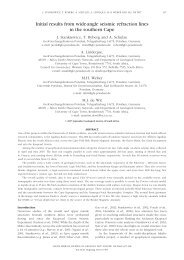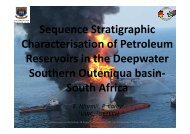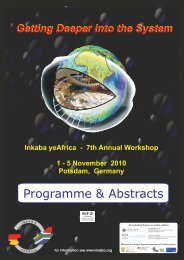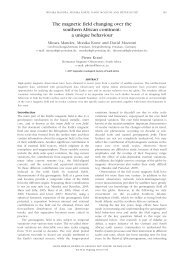South Africa - Inkaba.org
South Africa - Inkaba.org
South Africa - Inkaba.org
Create successful ePaper yourself
Turn your PDF publications into a flip-book with our unique Google optimized e-Paper software.
Downscaling climate change scenarios to daily maximum<br />
temperatures over Bloemfontein, <strong>South</strong> <strong>Africa</strong><br />
P.C. Tharaga and A.S. Steyn<br />
Department of Soil Crop and Climate Science, University of the Free State, <strong>South</strong> <strong>Africa</strong>,<br />
2005162884@ufs4life.ac.za<br />
ABSTRACT<br />
Climate change refers to a change in the state of the climate that can be recognised by changes in the mean and/or<br />
the variability of its properties and that continues for an extended period, typically decades or longer. Climate<br />
change may be limited to a specific region, or may occur across continents or the whole planet. Global Circulation<br />
Models (GCMs) are the main source of climate projections under varying greenhouse gas emission scenarios, but<br />
their output needs to be downscaled before it can be interpreted for point stations. The main objective of this study<br />
was to downscale and quantify the projected changes in maximum temperatures that can be expected in<br />
Bloemfontein within the 21 st century.<br />
A statistical downscaling model (SDSM) was employed. SDSM reduces the task of statistical downscaling into the<br />
following discrete steps: quality control, predictor screening, model calibration, generation of ensembles of future<br />
data for the baseline climatic period using observed predictors, statistical analysis, generating of ensembles of<br />
future weather data using GCM-derived predictors, and time series analysis. The model was calibrated and tested<br />
with the use of observed datasets of daily temperature as the predictand and normalised NCEP variables as the<br />
predictors. SDSM was then used to construct downscaled daily temperature projections under the A2 and B2<br />
emission scenarios as obtained from the HadCM3 model. The projected changes for the future climate were<br />
assessed by means of delta statistics.<br />
Predictor screening revealed that the most important predictors for maximum temperature were mean sea level<br />
pressure and 500 hPa height, probably because of the relationship to column thickness (which were not available as<br />
a predictor variable). Wind direction was also included as a predictor variable because of its apparent influence on<br />
temperatures in mid-latitudes. Preliminary results of the downscaling model will be presented.<br />
KEYWORDS: climate change, statistical downscaling, maximum temperature<br />
79









